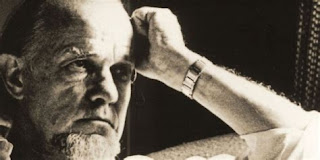At some point while I was studying geology in Aberystwyth
I read Art and the Bible. I had no
idea, then, how foundational that little book would be in my life. Recently I
realized that Schaeffer’s ‘Four Standards of Judgment’ (Complete Works, Vol. 5, pp. 399ff.) have been shaping my
interaction with culture ever since. Let me share them with you with the prayer
that they will be as helpful to you as they have been to me.
Schaeffer, writing about a Christian approach to art in
particular (I hope you can see how it applies to culture in general) argues
that “there are four basic standards: (1)
technical excellence; (2) validity; (3) intellectual content, the world-view
which comes through; and (4) the integration of content and vehicle”
(emphasis in the original).
- By technical excellence Schaeffer is talking about, for painting, “the use of color, form, the texture of the paint, the handling of lines, the balance, composition and the unity of the painting, and so forth”. In other words, how well the work of art is executed. “We are not being true to the artist as a man if we consider his art work junk simply because we differ with his outlook on life.....Man must be treated fairly as man.”
- By validity Schaeffer means “whether an artist is honest to himself and to his world-view, or whether he makes his art only for money or for the sake of being accepted.” He talks about the difficulty an artist is in if he paints for a patron (whether an old nobleman or a modern art gallery). There is a real tension here and it affects the ‘art’ of preaching as Schaeffer points out. My students often struggle with this concept. When I say that a society that has rejected the idea of a God to whom we are accountable is valid in approving of euthanasia frowns appear around the room. A cultural artefact, a piece of art by Damien Hurst or a social practice such as abortion may be completely valid, if it matches the world-view of the actor. That doesn’t mean it is ‘good’. It may be completely horrifying. But it would not be, for that, invalid.
- Schaeffer’s third criterion is worldview: “The third criterion for the judgment of a work of art is its content, that which refers to the world-view of the artist” (emphasis in the original). The question here is whether the creator of the work of art or whatever has produced something that reflects the truth or falsehood – in Schaeffer’s words, whether a Christian worldview is shown through it or not.
- “The fourth criterion for judging a work of art involves how well the artist has suited the vehicle to the message” (emphasis in the original). Schaeffer has in mind here the idea of congruence: does the form suit the message that the creator wants to convey? To be told you have cancer by your doctor with a smile on his face is to experience incongruence. Picasso’s Guernica, with its broken images of broken people and broken animals is a piece of art in which the form of the art is congruent with the subject.
Over the decades since I first read those standards they
have prompted me, cajoled me, corrected me and aided me (mostly sub-consciously
I am sure) in my quest to understand and evaluate culture. They continue to
help me to avoid two equal and opposite errors: (1) thinking that a cultural
form is bad just because I don’t like it (the error of ethnocentrism, or just
plain selfishness); and (2) thinking that all cultural forms are equally
acceptable (the error of relativism). It is possible, then, to look at a West
African spirit mask or listen to a drug-fuelled electric guitar solo or watch a
Hindu dance-drama and appreciate them without agreeing with the worldview of
their creators. It is also possible to critique a piece of so-called Christian
music or art, not because it does not convey true content (Schaeffer’s third
criterion) but because it does so in a poorly executed (criterion 1), invalid (criterion
2) and tacky (criterion 4) way.
I have much to be thankful for that I was taken to watch
those Schaeffer films. I am still trying to work out the implications of his
advice three and a half decades later.

No comments:
Post a Comment